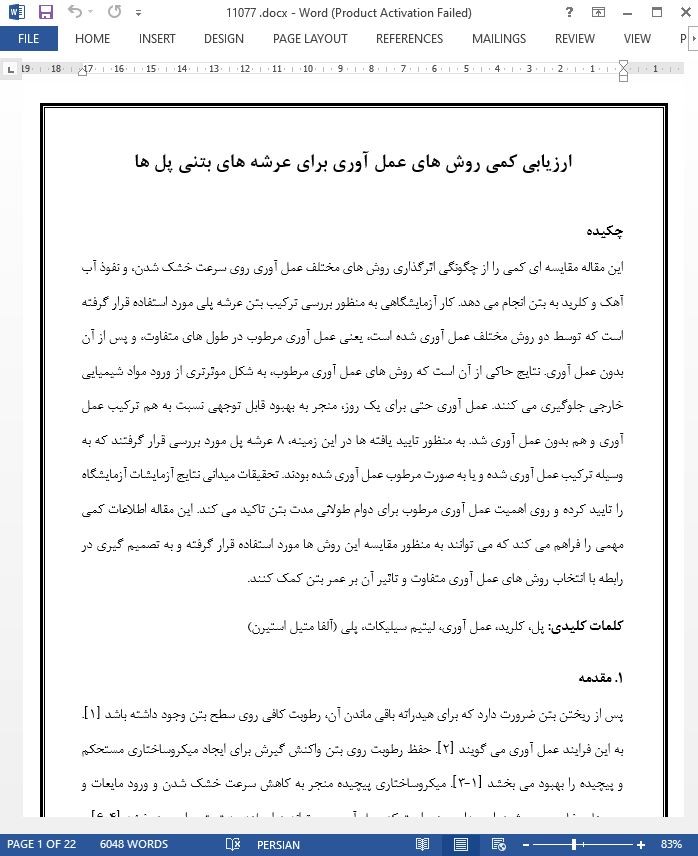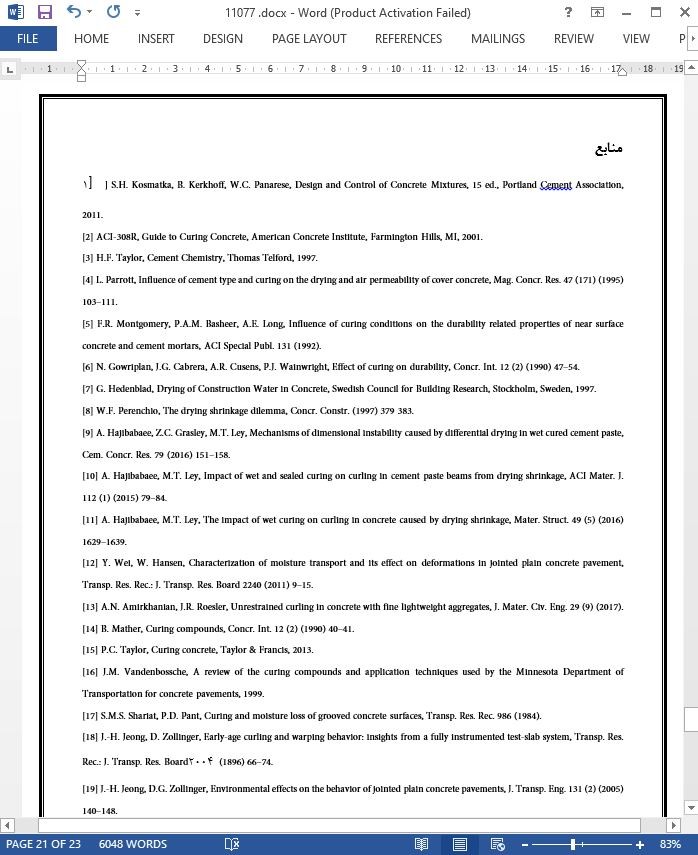
ارزیابی کمی روش های عمل آوری برای عرشه های بتنی پل ها
چکیده
این مقاله مقایسه ای کمی را از چگونگی اثرگذاری روش های مختلف عمل ¬آوری روی سرعت خشک شدن، و نفوذ آب آهک و کلرید به بتن انجام می دهد. کار آزمایشگاهی به منظور بررسی ترکیب بتن عرشه پلی مورد استفاده قرار گرفته است که توسط دو روش مختلف عمل آوری شده است، یعنی عمل آوری مرطوب در طول های متفاوت، و پس از آن بدون عمل آوری. نتایج حاکی از آن است که روش های عمل آوری مرطوب، به شکل موثرتری از ورود مواد شیمیایی خارجی جلوگیری می کنند. عمل آوری حتی برای یک روز، منجر به بهبود قابل توجهی نسبت به هم ترکیب عمل آوری و هم بدون عمل آوری شد. به منظور تایید یافته ها در این زمینه، 8 عرشه پل مورد بررسی قرار گرفتند که به وسیله ترکیب عمل آوری شده و یا به صورت مرطوب عمل آوری شده بودند. تحقیقات میدانی نتایج آزمایشات آزمایشگاه را تایید کرده و روی اهمیت عمل آوری مرطوب برای دوام طولانی مدت بتن تاکید می کند. این مقاله اطلاعات کمی مهمی را فراهم می کند که می توانند به منظور مقایسه این روش ها مورد استفاده قرار گرفته و به تصمیم گیری در رابطه با انتخاب روش های عمل آوری متفاوت و تاثیر آن بر عمر بتن کمک کنند.
1. مقدمه
پس از ریختن بتن ضرورت دارد که برای هیدراته باقی ماندن آن، رطوبت کافی روی سطح بتن وجود داشته باشد [1]. به این فرایند عمل آوری می گویند [2]. حفظ رطوبت روی بتن واکنش گیرش برای ایجاد میکروساختاری مستحکم و پیچیده را بهبود می بخشد [1-3]. میکروساختاری پیچیده منجر به کاهش سرعت خشک شدن و ورود مایعات و یون های خارجی می شود. این بدان معنی است که عمل آوری می تواند دوام بلند مدت بتن را بهبود بخشد [4-6].
عمل آوری مرطوب به طور مکرر رطوبت را برای سطح بتن تامین می کند [1و2]. با این حال، چالش های در زمینه اجزای بتنی وجود دارد که از یک سمت خشک شدن آن ها اتفاق می افتد مانند خیابان ها [2و7و8]. به عنوان مثال، خیابان های بتنی در یک محیط گرم، می تواند از تفاوت بزرگ در میزان انقباض پس از پایان عمل آوری مرطوب آسیب ببیند که این امر منجر به بی ثباتی در ابعاد شده که به آن پیچش می گویند [9-13].
4. نتیجه گیری
این تحقیق به مقایسه کمی اثرات روش های عمل آوری مختلف روی میزان تبخیر در زمان خشک شدن، جذب رطوبت بعدی، و نفوذ Cl می پردازد که به افراد این امکان را می دهد تا تصمیم گیری کنند که روش های ساخت آن ها چگونه روی بتنشان تاثیر می گذارد.
نتایج زیر را می توان بدست آورد:
• نمونه هایی که عمل آوری نشده بودند بدترین عملکرد را داشتند.
• عمل آوری مرطوب به میزان قابل توجهی کاهش حجم در طی خشک شدن، افزایش حجم ناشی از جذب، و نفوذ محلول NaCl را کاهش داد.
• با افزایش زمان عمل آوری مرطوب عملکرد بتن نیز در این آزمایش ها بهبود یافت، با این حال، برای این مصالح و این آزمایش بهبود اندکی پس از 7 روز مشاهده گردید. پیش از تغییر روش ها روش این نتایج باید برای طیف گسترده ای از مصالح مورد بررسی قرار گیرد.
Abstract
This paper gives a quantitative comparison of how different curing methods impact the rate of drying and subsequent penetration of lime water and chloride penetration of concrete. Laboratory work is used to investigate a bridge deck concrete mixture cured by two different curing compounds, wet curing of different lengths, and then no curing. The results confirm that wet curing methods reduce the ingress of external chemicals more effectively. The wet curing for even one day provided significant improvement over both curing compounds and no curing. To confirm the findings in the field eight bridge decks were investigated that were cured with a curing compound and wet curing. The field investigation confirms the findings of the laboratory testing and emphasizes the importance of wet curing for long term durability of concrete. This paper provides important quantitative data that can be used to compare these methods and help with making decisions about different curing practices and the impact on the service life of concrete.
1. Introduction
After casting concrete it is typically necessary to maintain sufficient moisture content on the surface to sustain hydration [1]. This process is called curing [2]. Maintaining the moisture in concrete promotes reaction of the binder to develop a torturous and strong microstructure [1–3]. A torturous microstructure will reduce the drying rate and the ingress of fluids and external ions. This means that curing can improve the long-term durability of concrete [4–6].
Wet curing continuously supplies moisture to the surface of the concrete [1,2]. However, there are challenges in curing concrete elements that dry from one side, such as pavements [2,7,8]. For example, concrete pavement in a dry environment can suffer from large differential drying shrinkage after the termination of wet curing which can lead to dimensional instability, called curling [9–13].
4. Conclusions
This work provides quantitative comparisons of the impact of different curing methods on the evaporation rate during drying, subsequent moisture uptake, and Cl penetration that can help practitioners decide how their construction practices impacts the durability of their concrete. The following conclusive remarks can be made:
- The samples that were uncured showed the worst performance of the investigated samples.
- Wet curing significantly reduced the mass loss during drying, mass gain from sorption, and the penetration of NaCl solution.
- As the wet curing was increased then so was the durability performance in these tests; however, there was a little improvement after 7 days of wet curing with these materials and in this testing. This finding should be investigated with a wider range of materials before changes in practice are made.
چکیده
1. مقدمه
2. روش های تجربی
2.1 مصالح، نسبت مخلوط و روش ها
2.2 آماده سازی نمونه، ریختن در قالب و عمل آوری
2.3 اندازه گیری وزن از دست رفته
2.4 قرار گیری در آب آهک
2.5 قرارگیری در محلول NaCl
2.6 μXRF
2.7 نمونه برداری و آزمایشات میدانی
3. نتایج و بحث
3.1 آزمون های آزمایشگاهی
3.2 نمونه های میدانی
3.3 ملاحظات عملی
4. نتیجه گیری
Abstract
1. Introduction
2. Experimental methods
2.1. Materials, mixture proportion, and procedures
2.2. Sample Preparation, Casting, and curing
2.3. Weight loss measurement
2.4. Storage in limewater
2.5. Storage in NaCl solution
2.6 μXRF
2.7. Field sample acquisition and testing
3. Results and discussion
3.1. Laboratory experiments
3.2. Field samples
3.3. Practical considerations
4. Conclusions
- اصل مقاله انگلیسی با فرمت ورد (word) با قابلیت ویرایش
- ترجمه فارسی مقاله با فرمت ورد (word) با قابلیت ویرایش، بدون آرم سایت ای ترجمه
- ترجمه فارسی مقاله با فرمت pdf، بدون آرم سایت ای ترجمه



